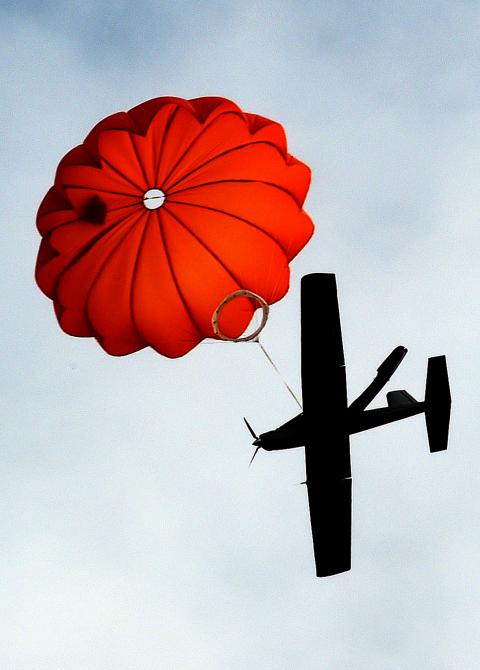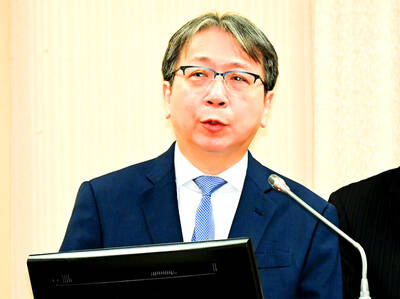The nation’s defense and air reconnaissance capabilities have been significantly enhanced with unmanned aerial vehicles (UAVs) and other cutting-edge systems and devices, which were unveiled yesterday by the Chungshan Institute of Science & Technology (CSIST).
The demonstration of remote-controlled aircraft and new pilot-training simulators took place at the institute’s Aeronautical Systems Research Division in Greater Taichung.
A small, 5kg battery-powered drone, named “Cardinal,” can be launched by hand and has a one-hour flight time and a range of 8km, division officials said. It is piloted by remote control by an operator via wireless link at a mobile station, they said.

Photo: Chien Jung-fong, Taipei Times
Division director Ma Wan-june (馬萬鈞) said the small aircraft has the advantages of portability, ease of operation and the capability to gather aerial intelligence.
“Taiwan’s indigenous UAV’s have bolstered the range and capacity of the military’s air reconnaissance and surveillance missions, and also assist the navy and Coast Guard Administration to defend our marine territories,” he said.
“The aircraft can also be used for disaster relief and rescue missions; aerial photography for assessing environmental changes; monitoring of forest and mountain regions; and management of agriculture and water resources,” Ma said.
The Cardinal yesterday was launched by a handler who flew it over a field as it provided a continuous feed of aerial imaging signals, GPS information and other data to the computers at its ground control station.
After popping open a parachute, the drone touched down for retrieval and reuse.
“It is outfitted with an electro-optical and infrared imaging system, which can rotate 360o for wide-angle coverage. It can also carry out missions at night with its infrared bands,” Ma said.
A bigger drone called the “Albatross” weighs 317kg, has an 8m wingspan, a flight time of 10 hours and a 150km range, he said.
The Albatross can also carry heavier payloads, he said.
He said all of the drone fleet models were developed by the division, with the production and integration of components coming from more than 20 Taiwanese companies, generating NT$1.34 billion (US$42.95 million) in derived business revenues.
Officials at yesterday’s demonstration would not confirm whether the drones are able to carry missiles and other weapons.
They said a technical service team would be established shortly to allow government agencies access to the drone fleet for various uses.
The demonstration also included a flight simulator for training pilots, combat simulators for soldiers and the TFE-1042 turbofan engine, which can be converted into an electrical generator.
The TFE-1042 was developed to power the Indigenous Defense Fighter (IDF) jets and is now targeted for the “green energy” sector, as the engine can burn methane gas from biodegradable garbage and animal waste.
Ma said the institute has had a lot of inquiries from around the world for the engine, while estimating potential derived revenue to reach about NT$40 billion in the coming years.

The US government has signed defense cooperation agreements with Japan and the Philippines to boost the deterrence capabilities of countries in the first island chain, a report by the National Security Bureau (NSB) showed. The main countries on the first island chain include the two nations and Taiwan. The bureau is to present the report at a meeting of the legislature’s Foreign Affairs and National Defense Committee tomorrow. The US military has deployed Typhon missile systems to Japan’s Yamaguchi Prefecture and Zambales province in the Philippines during their joint military exercises. It has also installed NMESIS anti-ship systems in Japan’s Okinawa

TRAGEDY STRIKES TAIPEI: The suspect died after falling off a building after he threw smoke grenades into Taipei Main Station and went on a killing spree in Zhongshan A 27-year-old suspect allegedly threw smoke grenades in Taipei Main Station and then proceeded to Zhongshan MRT Station in a random killing spree that resulted in the death of the suspect and two other civilians, and seven injured, including one in critical condition, as of press time last night. The suspect, identified as a man surnamed Chang Wen (張文), allegedly began the attack at Taipei Main Station, the Taipei Fire Department said, adding that it received a report at 5:24pm that smoke grenades had been thrown in the station. One man in his 50s was rushed to hospital after a cardiac arrest

ON ALERT: Taiwan’s partners would issue warnings if China attempted to use Interpol to target Taiwanese, and the global body has mechanisms to prevent it, an official said China has stationed two to four people specializing in Taiwan affairs at its embassies in several democratic countries to monitor and harass Taiwanese, actions that the host nations would not tolerate, National Security Bureau (NSB) Director-General Tsai Ming-yen (蔡明彥) said yesterday. Tsai made the comments at a meeting of the legislature’s Foreign Affairs and National Defense Committee, which asked him and Minister of National Defense Wellington Koo (顧立雄) to report on potential conflicts in the Taiwan Strait and military preparedness. Democratic Progressive Party (DPP) Legislator Michelle Lin (林楚茵) expressed concern that Beijing has posted personnel from China’s Taiwan Affairs Office to its

‘ILLEGAL RULING’: The KMT and the TPP slammed the Constitutional Court judgement, saying it contravened the law and was trying to clear the way for a ‘green dictatorship’ The Constitutional Court yesterday ruled that amendments to the Constitutional Court Procedure Act (憲法訴訟法) passed by the Legislative Yuan last year are unconstitutional, as they contravene due legislative process and separation of powers. The Legislative Yuan on Dec. 20 last year passed amendments stipulating that no fewer than 10 grand justices must take part in deliberations of the Constitutional Court, and at least nine grand justices must agree to declare a law unconstitutional. The Executive Yuan on Jan. 2 requested that lawmakers reconsider the bill, but the Legislative Yuan, under a combined majority of Chinese Nationalist Party (KMT) and Taiwan People’s Party